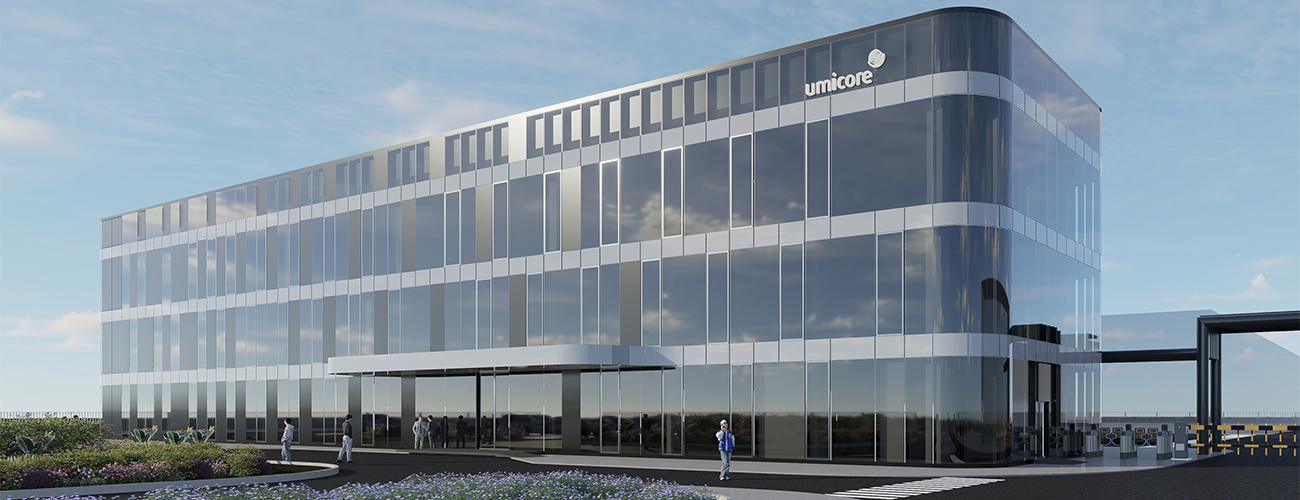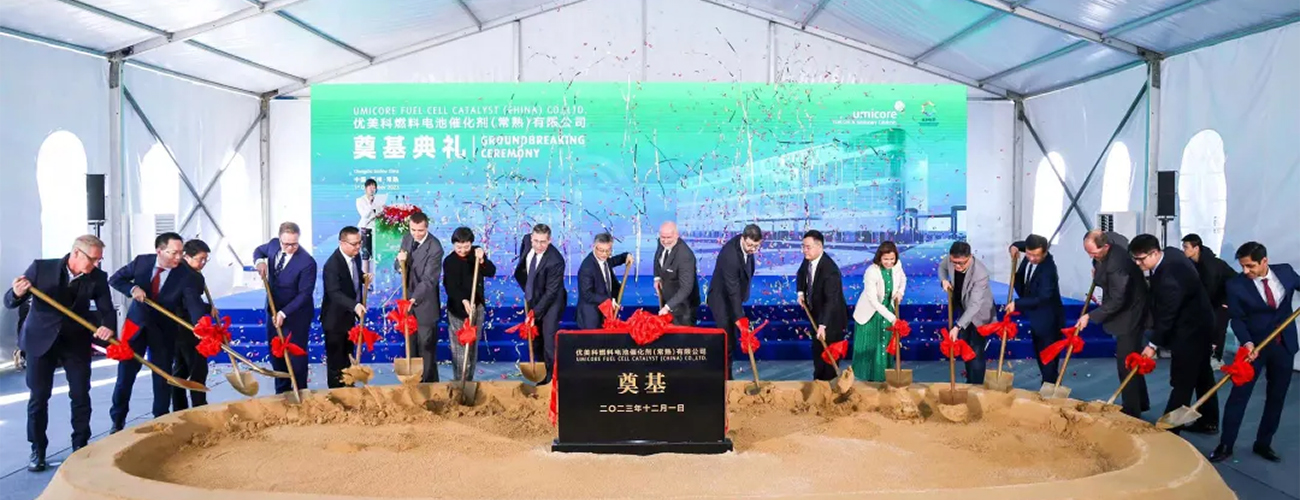Gearing up for a fuel cell future

As China becomes a hub for the growing international fuel cell vehicle market, Umicore is getting ready to meet demand with a new greenfield plant in Changshu. This new plant is expected to become the world’s largest fuel cell catalyst production facility to date. Joakim Thøgersen, Senior Vice President Fuel Cells & Stationary Catalysts, shares the journey so far.
"The new greenfield site in China is a prime strategic location, perfectly positioning us to cater for demande and leading the way in the latest fuel cell technologies."
Joakim Thøgersen, Senior VP Fuel Cells & Stationary Catalysts
How was 2023 a milestone year for Umicore’s ambition in fuel cell catalysts?
It was a very busy year and a very important one for us. We literally laid the foundations for the future of our fuel cell catalyst business with the ground-breaking ceremony for our new plant in Changshu on December, 1st. It was a proud moment. When fully operational, this will be the largest fuel cell catalyst plant in the world. Umicore is already a global leader in fuel cell catalysts for the mobility segment, so this new greenfield site, in a prime strategic location, perfectly positions us to cater for growing demand and lead the way in the latest fuel cell technologies.
Why did Umicore decide to build in China?
Over the past 30 years we’ve successfully grown to become a market leader in the field with our production and R&D footprint in Hanau, Germany and Songdo, Korea. Having recognized the need to increase capacity of fuel cell catalysts to meet global demand, the next step was deciding whether to expand in Europe, North America or China. Our decision was relatively easy in the end: we strongly believe the fuel cell market will take off in China first. After all, more than 90% of the fuel cell trucks sold over the last five years were in China, which makes this fertile ground for a burgeoning fuel cell market. It helps that fuel cell technology features in the Chinese Government’s Five-Year Plan. There will be bumps in the road – such as the current economic climate – but there is always some uncertainty in the energy transition.

What factors will influence the development of the fuel cell vehicle market?
A prerequisite for the market development is the development of hydrogen infrastructure and availability of hydrogen at refuelling stations. Future projections show that TCO (total cost of ownership) of fuel cell vehicles is expected to be lower than the TCO of diesel technology, with the cost of hydrogen being a key factor. Market penetration will also depend on the cost and adaptation of battery electric vehicles in various vehicle segments.
How will the plant complement Umicore’s existing facilities in South Korea and Germany?
First of all, the Changshu plant will be a lot bigger than our existing fuel cell catalyst production sites. And secondly, we want to optimize utilization as much as possible. Production in Korea will focus on alloy catalysts in the future, which can offer better fuel efficiency. The new plant in China will begin with platinum catalysts, which are inherently more stable and therefore easier to manage from an operational perspective. It’s not possible to mix these products on the same line, which means we need independent production lines. We can’t say which technology will prevail, so we plan for the plant in China to produce both product types in the longer term. While we work to get the Changshu plant up and running, we’ll bridge our production capacity in Germany, where we will continue making fuel cell catalysts including electrolyser catalysts for hydrogen production.
“Personally, I felt a huge sense of achievement and it was also very clear to see the pride in the eyes of our people.”
Joakim Thøgersen, Senior Vice President Fuel Cells & Stationary Catalysts
What did the ground-breaking ceremony mean to you and the team?
Personally, I felt a huge sense of achievement and it was also very clear to see the pride in the eyes of our people. However, we all know there’s a lot more work to do to secure more customers and get our products ready. This was a rewarding culmination of my work so far in China. Before joining Umicore, I was a managing director of my former company there, and have around 10 years’ experience working with or in the country. I could never have imagined that my career would lead me here, breaking ground for the world’s biggest fuel cell catalyst plant.
It’s very important in Chinese culture to mark these milestone events in the right way, so it felt like a very special day for me and the whole team. As well as highranking government officials, we also enjoyed the company of our customers and some of China’s top professors in this field. As a former researcher, that made me very happy! I think all the dots came together that day and it was a perfect way to begin this exciting journey of the emerging growth in fuel cell technology.
Can you describe the process of setting up in China?
We began the journey in late 2020, when the world was still in the grips of the Covid pandemic, so it was a real challenge to start building a business in the country at this time. The first step was getting a strong local team in place, something I’ve always believed is key to doing successful business in China. To do that, I needed to be on-site, which meant a lot of travelling and quarantining. At one point, I had to spend 28 consecutive days isolating in one hotel room! It was all worth it though, as we were able to bring together a very strong team that ensured we could celebrate the ground-breaking by the end of 2023, and who will help us meet the tight timelines of the projected market demand in China.
Anything else that triggered the location choice?
After site-screening several chemical parks, we set up in Changshu, partly because of its proximity to Shanghai and Suzhou, where Umicore already has a presence. The local government provided also incentives to facilitate our project and we eventually became a Suzhou “key project”. We were also eager to form good relationships with senior officials, and in fact, many of them, including the Party Secretary, an administrative Mayor and the local Mayor, attended the ground-breaking ceremony. We knew it was important to engage with those on the operational side too, such as the Environmental Protection Bureau.

How will the plant operate sustainably?
We plan for our Scopes 1 and 2 emissions to be carbon neutral, depending on a ready availability of green electricity. We will also be looking to minimize our Scope 3 emissions from our supply chain, which is why we’re asking our partners to optimize their CO2 footprint as much as possible. When it comes to circularity, we expect to recycle the fuel cell membranes, and there’s research ongoing to determine whether we can reuse different materials in the membranes.
What’s the growth plan for the new plant?
The plant is expected to be operational in 2026. We’ll start on a small scale, building up capacity gradually so that we can always operate in an optimized way. We’re a market leader in this area with a strong technical portfolio and partnerships with research institutes, industrial partners as well as global car manufacturers, so we’re well positioned to make this investment. Through cutting-edge fuel cell catalyst technology, this plant will play a key role in accelerating the transformation of hydrogen-based clean mobility.
